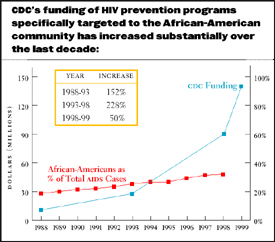

 |
|
 HIV prevention saves lives
HIV prevention saves lives
Overwhelming evidence proves that HIV
prevention efforts have saved countless lives,
both in the U.S. and worldwide:
• Prevention efforts have helped slow the rate of new infections
in the U.S. from over 150,000 per year in the late 1980’s to
40,000 today.
• HIV prevalence among young white men in the U.S. declined by
50% between 1988 and 1993. Occurring at a time of high overall
HIV prevalence, this decline marks a notable prevention success.
• Prevention efforts in New York City have contributed to a drop
in HIV prevalence among injection-drug users in drug treatment
from almost 34% in 1990 to just over 4% in 1998.
• The number of U.S. infants who acquire AIDS through mother-to-child
transmission has declined 73% from 1992 through 1998.
• Concentrated prevention efforts have turned around HIV
epidemics in Uganda (where AIDS cases in urban areas have
fallen by 50% since 1996) and Thailand, and have prevented
an expected epidemic in Senegal.
Fighting HIV where it ’s hitting hardest
 The CDC directs the largest portion of its HIV prevention efforts to the African-American
communities that have been hardest hit by HIV/AIDS:
• AIDS is the leading cause of death among African Americans ages 25-44.
The CDC directs the largest portion of its HIV prevention efforts to the African-American
communities that have been hardest hit by HIV/AIDS:
• AIDS is the leading cause of death among African Americans ages 25-44.
• African Americans represent an estimated 13% of the u.s. population,
yet they are believed to represent half of new HIV infections.
• Among African Americans, young gay men and young heterosexual women
are hardest hit.
Since 1987, CDC has steadily built and supported innovative programs in
African-American communities through national, regional and local
organizations, including community and faith-based organizations.
CDC also continues to work with Latino communities and others hard hit
by the epidemic to build and sustain effective prevention programs.
More critical than ever
There is still no cure for AIDS, and
an estimated 40,000 Americans
become infected with HIV every
year. With recent advances in
treatment, more people are living
with HIV infection and AIDS. This
means an increasing need for
prevention efforts to help those
infected maintain safer behaviors
and to help others at risk stay
uninfected.
More diverse than ever
Prevention efforts are aggressively
targeting a wider range of
communities than ever before,
including gay men of color,
African-American and Hispanic
women, white gay men, injection-drug
users, and adolescents as
they come of age.
More hope than ever
We are entering a new era in HIV
prevention, one in which scientific
research provides cutting-edge
behavioral and biomedical
approaches to prevention. Effective
risk reduction strategies, combined
with new treatments for HIV and
other sexually transmitted diseases,
offer more hope than ever of
further reducing the spread of HIV.
|
CDC: the nation’s leader in HIV prevention
HIV prevention means using every effective
weapon to stop new HIV infections from occurring.
The CDC works on these three fronts: |
2. Researching prevention
Biomedical The CDC conducts basic research
on the mechanics of HIV infection and disease
progression. It also conducts research on HIV prevention technologies:
• Impact of HIV treatment on transmission
• Prevention of mother-to-child STD transmission
• STD treatment as a method of HIV prevention
• Vaccines
• Microbicides
Behavioral The CDC develops and evaluates
prevention programs nationwide, many which provide information and social
support to groups at risk for HIV, such as:
• Peer outreach for gay men
• Street outreach for injection-drug users
• Education programs for youth in and out of school
• Faith-based initiatives in African-American communities
|
1. Helping communities
Each year, the CDC provides over $400 million to build and support
innovative prevention efforts, including:
• Funding programs run by 65 state, local and territorial health departments,
22 national and regional minority organizations, and
94 local organizations.
• Helping community organizations to implement and sustain
prevention
programs.
• Conducting training programs in effective approaches to prevention.
|
3. Tracking HIV/AIDS
The CDC’s unparalleled information-gathering systems track the occurrence and course of HIV throughout the U.S., indicating where prevention programs are most urgently needed now and in the future.
|
Revised: February 2001
Centers for Disease Control & Prevention
National Center for HIV, STD, and TB Prevention
Divisions of HIV/AIDS Prevention
Contact Us
|